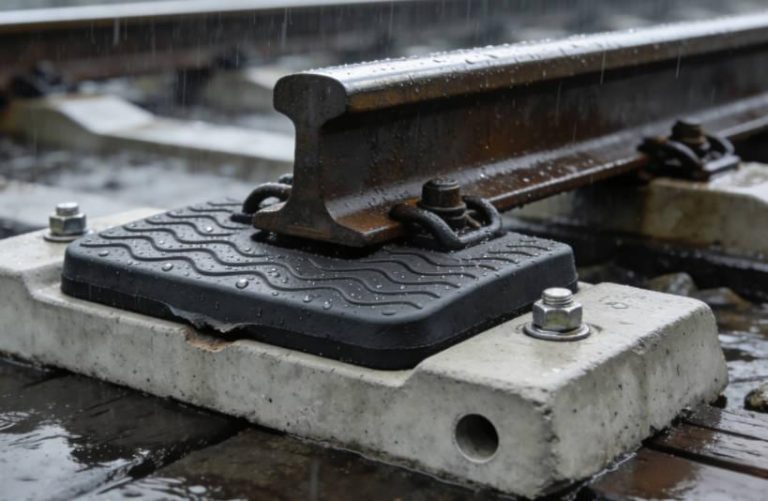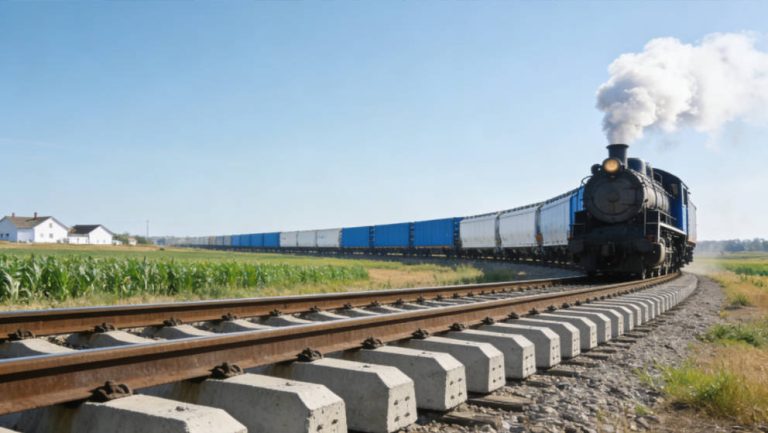The Invisible Threat to Track Integrity
Railway safety and smooth operations depend heavily on precise track geometry. The rail gauge—the distance between rail inner faces—is crucial. It ensures stable, safe train movement. Yet tracks face constant dangers. Stray electrical currents cause corrosion and signal problems. Heavy vibrations wear down components. Environmental stresses like humidity and temperature changes take their toll.
Rail gauge insulators are vital but often ignored. These components combat these multiple dangers. They maintain the critical rail gauge. At SAFE Rail Fastening System, we know high performance insulators are more than simple spacers. They protect track life. They defend operational safety. They ensure system reliability.
Beyond Spacers: What Rail Gauge Insulators Do
Rail gauge insulators perform several key roles
Essential Electrical Isolation
They block dangerous stray currents. This prevents signal interference. It stops electrolytic corrosion on rails, sleepers, and fasteners. Material purity matters greatly. So does dielectric strength. We use tough insulating composites. These include glass fiber reinforced poly amide, polyester resin, polyurethane, and polyoxymethylene.
Accurate Gauge Control
They keep the rails perfectly spaced. They withstand heavy trainloads. This reduces wheel and rail wear. Precise spacing prevents derailments. It boosts safety.
Vibration and Noise Control
They sit between the rail and the sleeper. This position absorbs shocks. It cuts noise from nearby areas. Less vibration extends component life.
Weather and Chemical Defense
Our insulators resist harsh conditions. They handle oil, fuel, and UV exposure. They perform in extreme heat or cold. This makes them ideal for tough locations. Think coastal zones or industrial areas.
The Real Cost of Insulator Failure
Ignoring insulators brings serious problems
Rapid Corrosion Damage
Failed insulation allows stray currents. These currents eat metal parts. Rails rust faster. Fasteners weaken. Replacements cost heavily.
Signal System Failures
Electrical leaks disrupt signals. This creates safety hazards. Trains might get the wrong commands.
Unstable Track Gauge
Worn insulators alter rail spacing. Gauges widen or narrow. Derailment risks rise. Wear accelerates.
Early Component Breakdown
Failed insulators stress nearby parts. Sleepers crack sooner. Clips fail. Rails degrade faster.
More Downtime, Higher Costs
Fixes become frequent. Inspections increase. Parts need early replacement. Service halts often. Profits drop.
Why Generic Insulators Fall Short
Modern railways demand specific solutions. One size fits all insulators cause issues. Consider these factors:
Traffic Load Differences
Heavy freight strains insulators hard. High speed passenger lines need vibration control. Light rail has unique demands.
Harsh Environments
Coastal salt eats weak materials. Desert heat cracks poor polymers. We pick materials for your exact weather.
Electrical Needs Vary
Signaling systems differ. Isolation requirements change. We custom engineer electrical performance.
Track Designs Differ
Concrete sleepers need one fit. Timber needs another. Steel bases require special designs. Compatibility is key.
Performance Goals Shift
Some prioritize electrical blocking. Others need vibration damping. We tune properties precisely.
SAFE Rail Fastening System solves this. We deliver customized solutions. They match your exact needs.
The SAFE Advantage: Precision Engineering
Smart Material Science
We pick advanced polymers for tough jobs. Our composites include glass fiber reinforced poly amide, polyester resin, polyurethane, and polyoxymethylene. They resist moisture. They endure chemicals. They insulate perfectly.
Exact Manufacturing
We use 100+ automated machines. Our injection molding line has central feeding. New presses ensure perfect shapes. Every piece matches specs. We follow ISO 9001, ISO 14001, and ISO 45001 strictly.
Total Custom Power
- We make common global types. We also build unique designs.
- We tweak formulations for your environment
- We reshape geometries for special fasteners
- We test every batch hard. Standards include EN 13146, EN 13481, TB/T 3065, and more.
Longer Track Life
Our insulators extend system durability. They stop corrosion. They maintain the gauge. They reduce wear.
Where Our Insulators Excel
SAFE insulators work worldwide in:
- Heavyhaul freight lines
- Highspeed rails
- Metro lines like Chengdu Line 17
- City interlinks like WuhanHuangshi
- Industrial tracks
- Bridges and tunnels
- Turnouts
They serve projects in Thailand, Germany, Saudi Arabia, Russia, and 10+ other countries.
Partner for Stronger Tracks
Choosing rail gauge insulators is strategic. It invests in safety. It cuts lifetime costs. SAFE Rail Fastening System partners with you. We solve complex track challenges. We engineer solutions—not just sell parts.
Act Now: Contact our engineers about your insulator needs. Discover standard and custom options
FAQ
Q: What do rail gauge insulators do?
A: They keep the rail spacing exact. They block electrical currents. They cut vibrations and noise. They resist weather damage.
Q: What materials does SAFE use?
A: We use strong composites. These include glass fiber reinforced poly amide, polyester resin, polyurethane, and polyoxymethylene.
Q: Can I get custom designs?
A: Yes. As OEM & OBM experts, we modify everything. Fit, materials, performance—we adjust it all.
Q: Where are they used?
A: Anywhere rails run: high speed lines, city metros, freight tracks, bridges, tunnels, and switches.
Q: What certifications apply?
A: We hold CRCC approval. We meet EN 13146 and EN 13481 via the TÜV NORD partnership.







